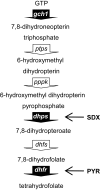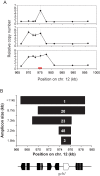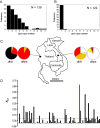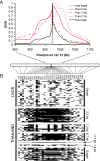Adaptive copy number evolution in malaria parasites
- PMID: 18974876
- PMCID: PMC2570623
- DOI: 10.1371/journal.pgen.1000243
Adaptive copy number evolution in malaria parasites
Abstract
Copy number polymorphism (CNP) is ubiquitous in eukaryotic genomes, but the degree to which this reflects the action of positive selection is poorly understood. The first gene in the Plasmodium folate biosynthesis pathway, GTP-cyclohydrolase I (gch1), shows extensive CNP. We provide compelling evidence that gch1 CNP is an adaptive consequence of selection by antifolate drugs, which target enzymes downstream in this pathway. (1) We compared gch1 CNP in parasites from Thailand (strong historical antifolate selection) with those from neighboring Laos (weak antifolate selection). Two percent of chromosomes had amplified copy number in Laos, while 72% carried multiple (2-11) copies in Thailand, and differentiation exceeded that observed at 73 synonymous SNPs. (2) We found five amplicon types containing one to greater than six genes and spanning 1 to >11 kb, consistent with parallel evolution and strong selection for this gene amplification. gch1 was the only gene occurring in all amplicons suggesting that this locus is the target of selection. (3) We observed reduced microsatellite variation and increased linkage disequilibrium (LD) in a 900-kb region flanking gch1 in parasites from Thailand, consistent with rapid recent spread of chromosomes carrying multiple copies of gch1. (4) We found that parasites bearing dhfr-164L, which causes high-level resistance to antifolate drugs, carry significantly (p = 0.00003) higher copy numbers of gch1 than parasites bearing 164I, indicating functional association between genes located on different chromosomes but linked in the same biochemical pathway. These results demonstrate that CNP at gch1 is adaptive and the associations with dhfr-164L strongly suggest a compensatory function. More generally, these data demonstrate how selection affects multiple enzymes in a single biochemical pathway, and suggest that investigation of structural variation may provide a fast-track to locating genes underlying adaptation.
Conflict of interest statement
The authors have declared that no competing interests exist.
Figures







Similar articles
-
Selection strength and hitchhiking around two anti-malarial resistance genes.Proc Biol Sci. 2005 Jun 7;272(1568):1153-61. doi: 10.1098/rspb.2004.3026. Proc Biol Sci. 2005. PMID: 16024377 Free PMC article.
-
Recurrent gene amplification and soft selective sweeps during evolution of multidrug resistance in malaria parasites.Mol Biol Evol. 2007 Feb;24(2):562-73. doi: 10.1093/molbev/msl185. Epub 2006 Nov 23. Mol Biol Evol. 2007. PMID: 17124182
-
Origin of robustness in generating drug-resistant malaria parasites.Mol Biol Evol. 2014 Jul;31(7):1649-60. doi: 10.1093/molbev/msu140. Epub 2014 Apr 16. Mol Biol Evol. 2014. PMID: 24739308 Free PMC article.
-
The molecular basis of antifolate resistance in Plasmodium falciparum: looking beyond point mutations.Ann N Y Acad Sci. 2015 Apr;1342(1):10-8. doi: 10.1111/nyas.12662. Epub 2015 Feb 18. Ann N Y Acad Sci. 2015. PMID: 25694157 Free PMC article. Review.
-
The evolutionary landscape of antifolate resistance in Plasmodium falciparum.J Genet. 2011 Aug;90(2):187-90. doi: 10.1007/s12041-011-0072-z. J Genet. 2011. PMID: 21869466 Free PMC article. Review.
Cited by
-
Harnessing genomics and genome biology to understand malaria biology.Nat Rev Genet. 2012 Apr 12;13(5):315-28. doi: 10.1038/nrg3187. Nat Rev Genet. 2012. PMID: 22495435 Review.
-
Copy number variation contributes to cryptic genetic variation in outbreak lineages of Cryptococcus gattii from the North American Pacific Northwest.BMC Genomics. 2016 Sep 2;17(1):700. doi: 10.1186/s12864-016-3044-0. BMC Genomics. 2016. PMID: 27590805 Free PMC article.
-
Industrial fuel ethanol yeasts contain adaptive copy number changes in genes involved in vitamin B1 and B6 biosynthesis.Genome Res. 2009 Dec;19(12):2271-8. doi: 10.1101/gr.094276.109. Epub 2009 Nov 6. Genome Res. 2009. PMID: 19897511 Free PMC article.
-
Plasmodium Genomics and Genetics: New Insights into Malaria Pathogenesis, Drug Resistance, Epidemiology, and Evolution.Clin Microbiol Rev. 2019 Jul 31;32(4):e00019-19. doi: 10.1128/CMR.00019-19. Print 2019 Sep 18. Clin Microbiol Rev. 2019. PMID: 31366610 Free PMC article. Review.
-
Artemisinin resistance in Plasmodium falciparum is associated with an altered temporal pattern of transcription.BMC Genomics. 2011 Aug 3;12:391. doi: 10.1186/1471-2164-12-391. BMC Genomics. 2011. PMID: 21810278 Free PMC article.
References
-
- Cooper GM, Nickerson DA, Eichler EE. Mutational and selective effects on copy-number variants in the human genome. Nat Genet. 2007;39:S22–S29. - PubMed
-
- Freeman JL, Perry GH, Feuk L, Redon R, McCarroll SA, et al. Copy number variation: new insights in genome diversity. Genome Res. 2006;16:949–961. - PubMed
Publication types
MeSH terms
Substances
Grants and funding
LinkOut - more resources
Full Text Sources
Other Literature Sources
Research Materials

